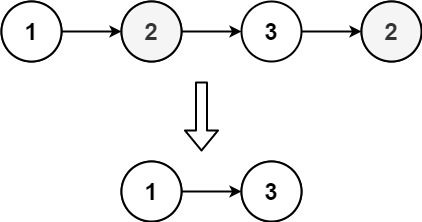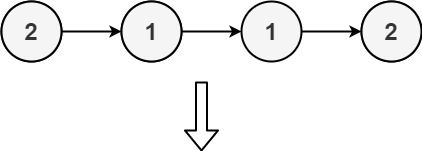哈希表
链表
题目描述
给定一个链表的第一个节点 head ,找到链表中所有出现多于一次 的元素,并删除这些元素所在的节点。
返回删除后的链表。
示例 1:
输入: head = [1,2,3,2]
输出: [1,3]
解释: 2 在链表中出现了两次,所以所有的 2 都需要被删除。删除了所有的 2 之后,我们还剩下 [1,3] 。
示例 2:
输入: head = [2,1,1,2]
输出: []
解释: 2 和 1 都出现了两次。所有元素都需要被删除。
示例 3:
输入: head = [3,2,2,1,3,2,4]
输出: [1,4]
解释: 3 出现了两次,且 2 出现了三次。移除了所有的 3 和 2 后,我们还剩下 [1,4] 。
提示:
链表中节点个数的范围是 [1, 105 ]
1 <= Node.val <= 105
解法
方法一:哈希表
我们可以用哈希表 \(cnt\) 统计链表中每个元素出现的次数,然后遍历链表,删除出现次数大于 1 的元素。
时间复杂度 \(O(n)\) ,空间复杂度 \(O(n)\) 。其中 \(n\) 为链表的长度。
Python3 Java C++ Go TypeScript
1
2
3
4
5
6
7
8
9
10
11
12
13
14
15
16
17
18
19
20
21 # Definition for singly-linked list.
# class ListNode:
# def __init__(self, val=0, next=None):
# self.val = val
# self.next = next
class Solution :
def deleteDuplicatesUnsorted ( self , head : ListNode ) -> ListNode :
cnt = Counter ()
cur = head
while cur :
cnt [ cur . val ] += 1
cur = cur . next
dummy = ListNode ( 0 , head )
pre , cur = dummy , head
while cur :
if cnt [ cur . val ] > 1 :
pre . next = cur . next
else :
pre = cur
cur = cur . next
return dummy . next
1
2
3
4
5
6
7
8
9
10
11
12
13
14
15
16
17
18
19
20
21
22
23
24
25
26
27 /**
* Definition for singly-linked list.
* public class ListNode {
* int val;
* ListNode next;
* ListNode() {}
* ListNode(int val) { this.val = val; }
* ListNode(int val, ListNode next) { this.val = val; this.next = next; }
* }
*/
class Solution {
public ListNode deleteDuplicatesUnsorted ( ListNode head ) {
Map < Integer , Integer > cnt = new HashMap <> ();
for ( ListNode cur = head ; cur != null ; cur = cur . next ) {
cnt . put ( cur . val , cnt . getOrDefault ( cur . val , 0 ) + 1 );
}
ListNode dummy = new ListNode ( 0 , head );
for ( ListNode pre = dummy , cur = head ; cur != null ; cur = cur . next ) {
if ( cnt . get ( cur . val ) > 1 ) {
pre . next = cur . next ;
} else {
pre = cur ;
}
}
return dummy . next ;
}
}
1
2
3
4
5
6
7
8
9
10
11
12
13
14
15
16
17
18
19
20
21
22
23
24
25
26
27
28 /**
* Definition for singly-linked list.
* struct ListNode {
* int val;
* ListNode *next;
* ListNode() : val(0), next(nullptr) {}
* ListNode(int x) : val(x), next(nullptr) {}
* ListNode(int x, ListNode *next) : val(x), next(next) {}
* };
*/
class Solution {
public :
ListNode * deleteDuplicatesUnsorted ( ListNode * head ) {
unordered_map < int , int > cnt ;
for ( ListNode * cur = head ; cur ; cur = cur -> next ) {
cnt [ cur -> val ] ++ ;
}
ListNode * dummy = new ListNode ( 0 , head );
for ( ListNode * pre = dummy , * cur = head ; cur ; cur = cur -> next ) {
if ( cnt [ cur -> val ] > 1 ) {
pre -> next = cur -> next ;
} else {
pre = cur ;
}
}
return dummy -> next ;
}
};
1
2
3
4
5
6
7
8
9
10
11
12
13
14
15
16
17
18
19
20
21
22 /**
* Definition for singly-linked list.
* type ListNode struct {
* Val int
* Next *ListNode
* }
*/
func deleteDuplicatesUnsorted ( head * ListNode ) * ListNode {
cnt := map [ int ] int {}
for cur := head ; cur != nil ; cur = cur . Next {
cnt [ cur . Val ] ++
}
dummy := & ListNode { 0 , head }
for pre , cur := dummy , head ; cur != nil ; cur = cur . Next {
if cnt [ cur . Val ] > 1 {
pre . Next = cur . Next
} else {
pre = cur
}
}
return dummy . Next
}
1
2
3
4
5
6
7
8
9
10
11
12
13
14
15
16
17
18
19
20
21
22
23
24
25
26
27
28 /**
* Definition for singly-linked list.
* class ListNode {
* val: number
* next: ListNode | null
* constructor(val?: number, next?: ListNode | null) {
* this.val = (val===undefined ? 0 : val)
* this.next = (next===undefined ? null : next)
* }
* }
*/
function deleteDuplicatesUnsorted ( head : ListNode | null ) : ListNode | null {
const cnt : Map < number , number > = new Map ();
for ( let cur = head ; cur ; cur = cur . next ) {
const x = cur . val ;
cnt . set ( x , ( cnt . get ( x ) ?? 0 ) + 1 );
}
const dummy = new ListNode ( 0 , head );
for ( let pre = dummy , cur = head ; cur ; cur = cur . next ) {
if ( cnt . get ( cur . val ) ! > 1 ) {
pre . next = cur . next ;
} else {
pre = cur ;
}
}
return dummy . next ;
}
GitHub



